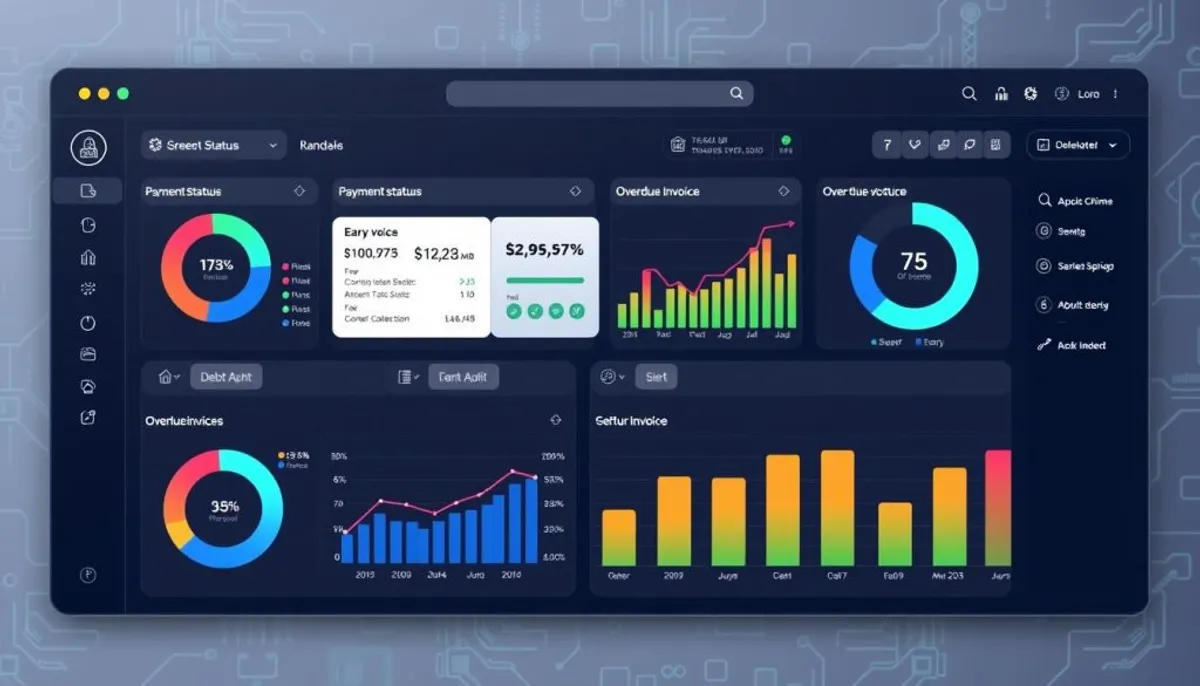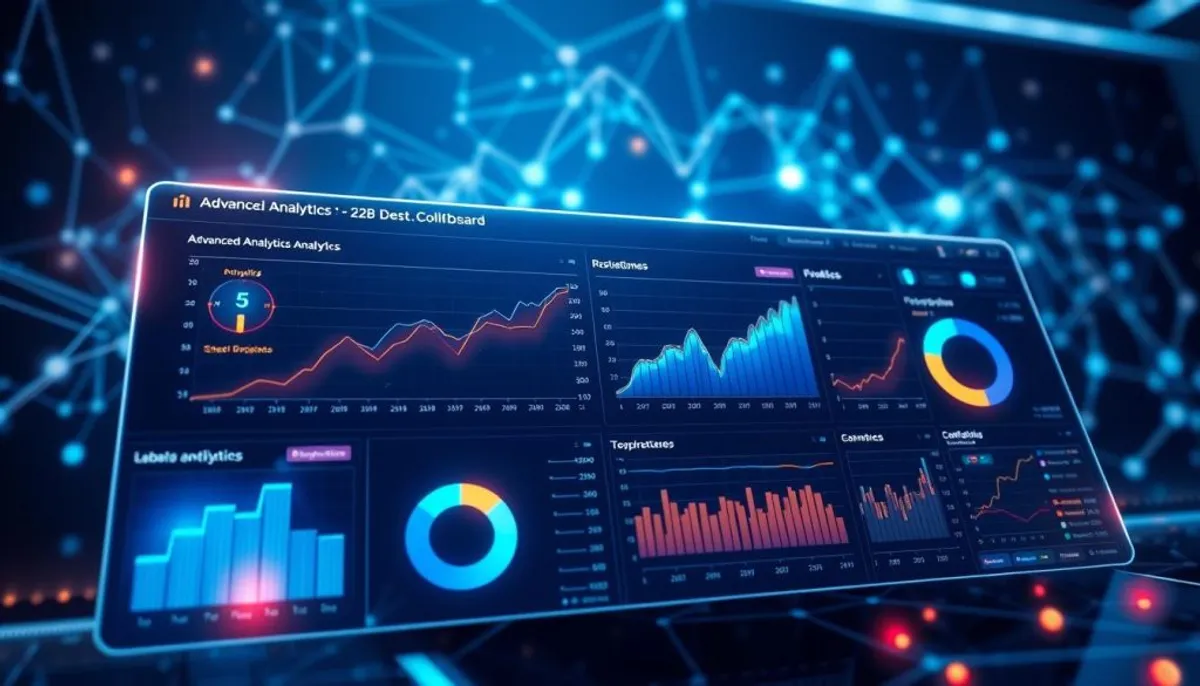In today’s fast-paced business world, b2b debt collection has become a critical aspect of financial management. Companies strive to maintain healthy cash flows, making efficient commercial accounts receivable management more pressing than ever. With 49% of businesses still relying on manual processes, the shift towards digital solutions is imperative.
Modern b2b debt collection strategies are revolutionizing financial handling. By embracing digital tools and automated systems, businesses see remarkable improvements in their collection processes. For instance, companies using advanced debt collection software report a 73% increase in efficiency and a 20% reduction in Days Sales Outstanding (DSO).

The impact of effective business debt recovery extends beyond just getting paid. It’s about streamlining operations, enhancing customer relationships, and boosting overall financial health. With the right approach, companies can turn the challenging task of debt collection into an opportunity for growth and improved business partnerships.
Key Takeaways
- Digital solutions are transforming b2b debt collection practices
- Automated systems can reduce DSO by an average of 20%
- 73% of users report improved collection efficiency with automated workflows
- Integration with accounting software enhances overall financial management
- Outsourcing debt collection can lead to cost savings and improved cash flow
Understanding Modern B2B Collections in the Digital Age
The B2B collections landscape has undergone profound transformations in recent years. Digital technologies have introduced new methods for managing corporate delinquent payments and streamlining inter-company debt resolution processes.
Evolution of Business Payment Systems
Business payment systems have evolved from manual to digital solutions. This evolution has led to more efficient and secure monetary management. For example, RHKCredit.com, launched on February 28, 2024, supports credit application processing, illustrating the industry’s shift towards digital solutions.
Impact of Digital Transformation
Digital transformation has revolutionized B2B collections. Smart automation, as employed by the RHK Team, has significantly enhanced the collections process efficiency. This technology enables teams to focus on critical accounts for personalized management, addressing the time-consuming task of tracking overdue payments.
Current Market Challenges
Despite technological advancements, businesses continue to face challenges in B2B collections. These include the need for faster transactions, improved accuracy, and enhanced cash flow. The article “Unraveling the Fabric of Trust” published on April 22, 2024, underscores the significance of credit research in evaluating a company’s creditworthiness, highlighting ongoing challenges in the field.
| Challenge | Solution |
|---|---|
| Time-intensive tracking of overdue payments | Smart automation and prioritization |
| Inaccuracies in collection processes | Modern software for financial data analysis |
| Need for faster transactions | Digital payment systems integration |
The Power of Electronic Invoicing Systems
Electronic invoicing systems are revolutionizing the management of b2b overdue invoices. They streamline the invoicing process, reducing errors and accelerating payments. By integrating with accounting software, e-invoicing eliminates manual data entry, thus speeding up cash flow.
E-invoicing is pivotal for business-to-business debt collection services. It facilitates automated reminders and follow-ups, significantly reducing unpaid bills. This technology enhances the efficiency and effectiveness of all business payments.
Countries globally are embracing e-invoicing standards to enhance business transactions:
- Brazil’s NF-e system necessitates specific fields and adaptable data elements
- Poland’s KSeF mandates structured XML formats
- Mexico’s CFDI system employs credit notes for error correction
- Italy’s SDI platform accommodates various invoice types
- India’s GSTN requires e-invoicing for B2B transactions
The European Union is at the forefront with Directive 2014/55/EU, standardizing e-invoicing fields. Germany mandates the XRechnung format for B2G transactions, while Spain’s SII system locks invoices after transmission.
| Country | E-Invoicing System | Key Feature |
|---|---|---|
| Brazil | NF-e | Fixed fields and adaptable data elements |
| Poland | KSeF | Structured XML formats |
| Mexico | CFDI | Credit notes for error correction |
| Italy | SDI | Multiple invoice types supported |
| India | GSTN | Mandatory for B2B transactions |
By 2025, invoice recipients must be able to process e-invoices. This transition will fundamentally change b2b overdue invoices management and improve business-to-business debt collection services. E-invoices must be stored in their original format for at least ten years, ensuring data integrity and machine readability.
B2B Debt Collection: Essential Strategies and Best Practices
Effective commercial debt recovery strategies are crucial for maintaining healthy cash flow in B2B relationships. Let’s explore key b2b accounts receivable solutions that can significantly improve your collection process.
Preventive Collection Measures
Implementing preventive measures is vital for successful B2B debt collection. Clear communication and proper documentation are essential. Maintain accurate records of invoices and agreements to avoid disputes. Recognize early warning signs of payment issues, such as requests for extended terms.
Automated Payment Reminders
Automation plays a crucial role in modern b2b accounts receivable solutions. Automated payment reminders streamline the collection process, reducing errors and improving efficiency. This approach allows for timely follow-ups on overdue payments without straining customer relationships.
Risk Assessment Protocols
Developing robust risk assessment protocols is key to effective commercial debt recovery strategies. Implement credit scoring models and utilize D&B reports for informed decisions. Regular reviews of credit limits based on risk assessments can help mitigate potential losses.
| B2B Collection Best Practices | Benefits |
|---|---|
| Clear communication | Reduces misunderstandings and disputes |
| Proper documentation | Supports claim resolution |
| Flexible payment plans | Improves chances of debt recovery |
| Automated reminders | Enhances efficiency and reduces errors |
| Risk assessment protocols | Mitigates potential losses |
By implementing these strategies, businesses can significantly improve their b2b accounts receivable solutions and maintain healthy cash flow. Remember, successful commercial debt recovery strategies hinge on proactive measures, clear policies, and leveraging automation for optimal results.
Introducing ti3: Revolutionizing Accounts Receivable Management
In the realm of b2b debt collection, ti3 emerges as a transformative force. This cutting-edge SaaS platform is engineered to streamline corporate debt collection processes. It redefines the approach to managing overdue accounts for businesses.
Platform Overview and Key Features
ti3 presents a comprehensive solution for enterprises grappling with unpaid invoices. It empowers users to automate their collection endeavors effortlessly. The platform boasts several pivotal features:
- Automated payment reminders
- Issue escalation tools
- Direct payment collection from overdue customers
- Streamlined workflow management
Automation Capabilities
ti3’s automation prowess distinguishes it in the b2b debt collection arena. Through advanced technology, it obviates the necessity for conventional debt collection agencies. This innovation not only reduces costs for businesses but also enhances the efficiency in retrieving overdue payments.
Customer Relationship Preservation
ti3 diverges from aggressive collection tactics, focusing instead on preserving client relationships. Its approach to corporate debt collection is both firm and respectful. This ensures that businesses can recover their due without alienating their customers. Such a delicate balance of effectiveness and tact makes ti3 an indispensable asset for companies aiming to enhance their accounts receivable management while safeguarding customer goodwill.
Smart Payment Solutions for Modern Businesses
In today’s fast-paced business world, smart payment solutions are revolutionizing commercial accounts receivable management. These innovative tools are transforming how companies handle business debt recovery, making it faster and more efficient than ever before.
The era of paper checks in B2B transactions is fading. Only 33% of US and Canadian businesses still rely on this outdated method. Forward-thinking companies are embracing electronic payment systems. In fact, 64% of businesses made over half their B2B payments electronically in 2022.
Automated Clearing House (ACH) payments have gained popularity, with 39% of North American businesses using them for recurring transactions. This shift towards automation is driving significant improvements in business debt recovery processes.
- Reduced processing times
- Fewer errors and manual labor
- Enhanced cash flow management
- Improved vendor relationships
B2B payment platforms are leading the charge in commercial accounts receivable management. These platforms offer real-time payment processing, automated invoicing, and comprehensive reporting tools. By adopting these solutions, businesses report improved efficiency and faster payment collection.
The benefits of smart payment solutions extend beyond speed and efficiency. They also provide valuable data insights, helping businesses make informed decisions about their financial strategies. With 54% of global companies prioritizing payment speed in cross-border transactions, these tools are becoming essential for staying competitive in the modern business landscape.
Leveraging AI and Machine Learning in Collections
AI and machine learning are revolutionizing B2B collections. These technologies empower businesses to effectively manage corporate delinquent payments and enhance inter-company debt resolution. By scrutinizing vast datasets, AI systems can forecast payment risks and refine collection tactics.

Predictive Analytics
Predictive analytics leverages historical data to forecast future payment behaviors. This method enables businesses to pinpoint at-risk accounts before they default. AI-driven solutions surpass traditional methods in predicting collection risks, analyzing extensive data on customer payment habits.
Automated Decision Making
AI streamlines the decision-making process in collections. It can automatically dispatch personalized reminders to defaulting customers across various digital platforms. The content of these messages is customized based on the customer’s risk profile, enhancing the likelihood of successful inter-company debt resolution.
Performance Optimization
Machine learning algorithms continually refine their predictions and strategies with new data. This leads to continuous performance enhancements in managing corporate delinquent payments. Industry reports indicate that advanced technologies have boosted debt recoveries by 65%.
| AI Impact | Improvement |
|---|---|
| Debt Recovery | 65% increase |
| Payment Arrangements | 40% increase |
| Collection Costs | 50% reduction |
By harnessing AI and machine learning, businesses can transition from reactive to proactive risk management. This shift reduces payment failures, minimizes collection costs, and boosts overall profitability in B2B transactions.
Subscription-Based Collection Models
B2B enterprises are increasingly adopting subscription-based and recurring billing models. This shift is transforming the landscape of business-to-business debt collection services. It introduces a more predictable income stream and diminishes the necessity for frequent invoicing.
These models prove highly effective for companies providing SaaS, memberships, or maintenance contracts. By adopting this system, businesses can notably reduce b2b overdue invoices. This, in turn, enhances their cash flow management.
The advantages of subscription-based collection models are manifold:
- Consistent revenue generation
- Reduced invoicing workload
- Improved cash flow forecasting
- Minimized debt collection efforts
Companies leveraging these models observe enhanced customer retention rates and increased lifetime value. This billing strategy simplifies business-to-business debt collection services. It also cultivates stronger, enduring client relationships.
For businesses grappling with b2b overdue invoices, transitioning to a subscription-based model offers a viable solution. It establishes a more stable financial base. This allows companies to concentrate on expansion, rather than solely focusing on payment recovery.
Blockchain Technology in B2B Payments
Blockchain is revolutionizing B2B payments, introducing innovative commercial debt recovery strategies and b2b accounts receivable solutions. It simplifies cross-border transactions, eliminating the delays and complexities inherent in traditional payment processes.
Smart Contracts Implementation
Smart contracts automate B2B payments, executing transactions upon the fulfillment of predetermined conditions. This automation accelerates invoice processing and approval, enhancing cash flow for businesses. By 2030, the global B2B payments market is forecasted to exceed $120 trillion annually, with blockchain technology at its core.
Security Features
Blockchain significantly enhances security in B2B transactions through its decentralized architecture. Each payment is documented on an immutable ledger, significantly reducing fraud risks. This technology is crucial for complex b2b accounts receivable solutions, fostering transparency and trust among parties.
Transaction Verification Process
Blockchain’s verification process is transforming commercial debt recovery strategies. It enables real-time transaction tracking, eliminating the challenges posed by time zone differences and settlement delays. This efficiency is driving more businesses to adopt blockchain for their B2B payments:
- 64% of enterprises now make B2B payments electronically
- Only 28% still handle transactions manually
- 58% of B2B organizations are likely to shift from checks to electronic payments
As blockchain technology continues to evolve, it promises to further streamline B2B payments. It offers faster, more secure, and cost-effective solutions for businesses globally.
Optimizing Cash Flow Through Advanced Analytics
Advanced analytics are pivotal in enhancing cash flow for B2B enterprises. Through the utilization of data-driven insights, corporations can refine their debt collection methodologies. This leads to a more efficient b2b debt collection process.

Real-time metrics and comprehensive dashboards empower businesses to monitor critical accounts receivable metrics. These analytics facilitate the comprehension of payment schedules, the tracking of Days Sales Outstanding (DSO), and the assessment of vital turnover ratios.
The integration of A/R automation software profoundly influences cash flow management:
- Reduce DSO by up to 30%
- Accelerate payment cycles
- Minimize bad debt risks
B2B Buy Now, Pay Later (BNPL) solutions, when combined with advanced analytics, significantly bolster cash flow management. These systems expedite payments and furnish real-time data for strategic decision-making.
| Metric | Impact of Advanced Analytics |
|---|---|
| Payment Speed | 25% faster on average |
| Bad Debt Risk | Reduced by up to 40% |
| Operational Efficiency | Improved by 35% |
By leveraging advanced analytics, businesses can optimize their b2b debt collection tactics. This results in enhanced cash flow and robust financial stability.
Building Strong Supplier-Customer Relationships
In the realm of business debt recovery and commercial accounts receivable management, fostering robust supplier-customer relationships is paramount. The value of B2B customers often exceeds that of mass-market consumers. Thus, it is imperative to cultivate positive connections throughout the entire business cycle.
Communication Strategies
Effective communication stands as the bedrock of successful B2B relationships. Documenting all interactions with clients, including follow-up emails after phone calls, is crucial. It prevents misunderstandings and fosters trust. Open dialogue can avert tension surrounding payments and resolve issues before they escalate.
Payment Plan Flexibility
Providing flexible payment options is vital for maintaining strong relationships while ensuring timely payments. This strategy includes:
- Customized payment schedules
- Early payment discounts
- Supplier financing programs
Trust Building Measures
Trust is the cornerstone of enduring B2B partnerships. Implementing the following measures can fortify relationships:
| Measure | Benefit |
|---|---|
| Transparent invoicing | Reduces disputes and fosters trust |
| Regular account reviews | Identifies potential issues early |
| Collaborative problem-solving | Strengthens partnerships |
By adopting these strategies, businesses can enhance their commercial accounts receivable management while safeguarding valuable customer relationships. This approach minimizes the necessity for aggressive debt collection tactics and supports long-term business success.
Conclusion
B2B debt collection has evolved, integrating technology with strategic approaches. Businesses now face challenges such as late payments and complex agreements. Effective strategies are essential. Automated invoicing systems and AI-driven analytics lead the way in business debt recovery efforts.
The b2b debt collection landscape is transforming, focusing on a customer-centric model. Companies are adopting multi-channel communication and personalized approaches. This ensures professional relationships are maintained while debts are recovered. The goal is to preserve valuable business connections during the collection process.
The future of B2B collections is bright, driven by advanced technologies. Blockchain for secure transactions and machine learning for predictive analytics are reshaping account management. By embracing these innovations, companies can streamline debt recovery, enhance cash flow, and build stronger business relationships.
RelatedRelated articles



